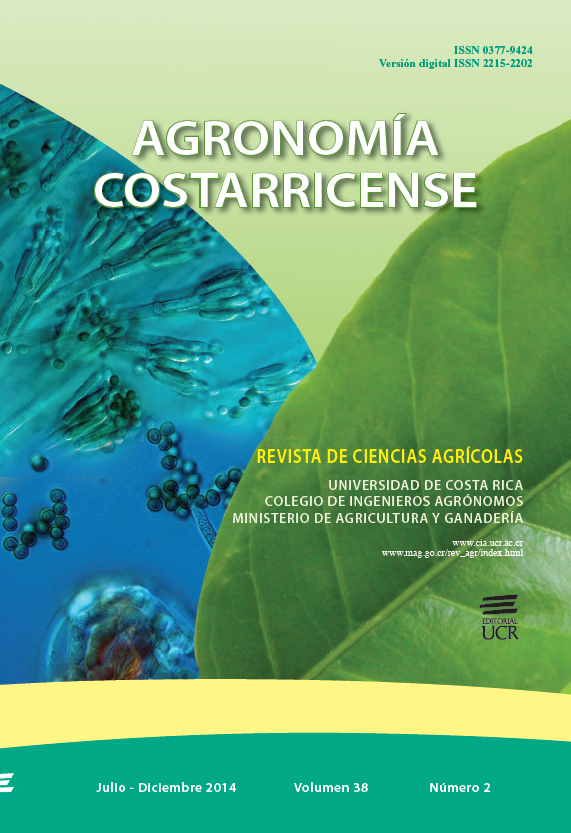Resumen
Durante el 2010, en una plantación comercial de papaya cv. “Pococí”, ubicada en Guácimo, Costa Rica, se determinó la curva de crecimiento del cultivo y las curvas de absorción de nutrimentos, mediante muestreos destructivos de plantas realizados desde el trasplante a partir de febrero del 2010 hasta 9 meses después del trasplante. Fueron obtenidas las curvas de absorción de nutrientes para un híbrido de alto rendimiento, así como sus requerimientos nutrimentales. Con una densidad de siembra de 1600 plantas por hectárea, se estimó que el híbrido “Pococí” requirió para su desarrollo hasta los 9 meses aproximadamente 354 kg.ha -1 de N, 101 kg.ha -1 de P 2 O 5 , 498 kg.ha -1 de K 2 O, 174 kg.ha -1 de CaO, 106 kg.ha -1 de MgO y 40 kg.ha -1 de S, cantidades requeridas que, en su mayoría, superan a las que normalmente están siendo aplicadas mediante los programas de fertilización en el país.Citas
BOGANTES A., HERNÁNDEZ M., MORA E. 2010a. Herbicidas para el control de Spermacoce tenuior
L. en papaya (Carica papaya). Agronomía Mesoamericana 21(1):185-192.
BOGANTES A., MORA E. 2004. Factibilidad técnica del uso de cobertura vegetal en papaya (Carica papaya L.) mediante la aplicación localizada de herbicida. Agronomía Mesoamericana 15(2):193-199.
BOGANTES A., MORA E. 2006. Validación del rendimiento del híbrido de papaya “Pococí” (Carica papaya) en el Caribe de Costa Rica. Revista Alcances Tecnológicos 4(1):53-58.
BOGANTES A., MORA E., UMAÑA G., LORÍA C. 2010b. Guía para la producción de la papaya en Costa Rica. Consultado: 25/06/2013. Disponible en http://www.eefb.ucr.ac.cr/images/Publicidad/Guia%20para%20la%20produccion%20de%20papaya%20en%20Costa%20Rica.pdf
CAMPOSTRINI E., GLENN D. 2007. Ecophysiology of papaya: a review. Braz. J. of Plant Physiol. 19(4):413-424.
CNP 2012. Análisis de Mercados Papaya. Consultado: 30/07/2013. Disponible en http://www.simacr.go.cr/index.php/papaya
COLLA G., ROUPHAEL Y., MIRABELLI C., CARDARELLI M. 2011. Nitrogen-use efficiency traits of mini-watermelon in response to grafting and nitrogen-fertilization doses. Journal of Plant Nutrition and Soil Science 174:933-941.
CUNHA R., HAAG H. 1980. Nutrição mineral do mamoeiro (Carica papaya L.). V- Marcha de absorção de nutrientes em condições de campo. Anais da Escola Superior de Agricultura “Luiz de Queiroz” 37:631-668.
DÍAZ-ROMEU R., HUNTER A. 1982. Metodología de muestreo de suelos, análisis químico de suelos y tejido vegetal y de investigaciones en invernadero.CATIE Turrialba. 61 p.
KIRAD K., BARCHE S., SINGH D. 2010. Integrated Nutrient Management in papaya (Carica papaya L.) cv. Surya. Acta Horticulturae 851:377-380.
KUMAR N., SOORIANATHASUNDARAM K., MEENAKSHI N., MANIVANNAN M., SURESH J., NOSOV V. 2010. Balanced fertilization in papaya (Carica papaya L.) for higher yield and quality. (Proc. 2nd IS on Papaya) Acta Horticulturae 851:357-362.
MARINHO C., OLIVEIRA M., MONNERAT P., VIANNI R., MALDONADO J. 2001. Fontes e doses de nitrogênio e a qualidade dos frutos do mamoeiro. Scientia Agricola 58(2):345-348.
MESQUITA E., CAVALCANTE L., GONDIM S., CAMPOS V., CAVALCANTE I., GONDIM P. 2010. Teores foliares e exportação de nutrientes do mamoeiro Baixinho de Santa Amália tratado com biofertilizantes. Pesq. Agropec. Trop. Goiânia 40(1):66-76.
NAUTIYAL B., SHARMA C., AGARWALA S. 1986. Iron zinc and boron deficiency in papaya. Scientia Horticulturae 1-2:115-123.
NELSON S. 2012. Boron deficiency of papaya. College of Tropical Agriculture and Human Resources.
University of Hawaii at Manoa. Plant disease PD-91. Consultado: 29/07/2013. Disponible en http://www.ctahr.hawaii.edu/oc/freepubs/pdf/PD-91.pdf
NISHINA M. 1991. Bumpy fruit of papaya as related to boron deficiency. Hawaii Inst. of Trop. Agric. And Human Resources, Commodity Fact Sheet PA-4 (B), Univ. of Hawaii. Consultado: 29/07/2013. Disponible en http://www.ctahr.hawaii.edu/oc/freepubs/pdf/CFS-PA-4B.pdf
OLIVEIRA A., CALDAS R. 2004. Produção do mamoeiro em função de adubação com nitrogênio, fósforo e potássio. Revista Brasileira de Fruticultura 26(1):160-163.
QIU Y., NISHINA M., PAULL R. 1995. Papaya fruit growth, calcium uptake, and fruit ripening. J. Amer. Soc. Hort. Sci. 120(2):246-253.
RAJBHAR P., SINGH G., LAL M. 2010. Effect of N, P, K and spacing on growth and yield of papaya (Carica papaya L.) cv. Pant Papaya 1. (Proc. 2 nd IS on Papaya) Acta Horticulturae 851:425-428.
AALAU E., BARRANTES W., LORÍA C., BRENES A., GÓMEZ L. 2009. Identificación mediante PCR del sexo de la papaya (Carica papaya L.), híbrido “Pococí”. Agronomía Mesoamericana 20(2):311-317.
SINGH D., PAUL P., GHOSH S. 2005. Response of papaya to foliar application of boron, zinc and their combinations. Research on Crops 6(2):277-280.
WANG D., KO W. 1975. Relationship between deformed- fruit disease of papaya and boron deficiency.
Phytopathology 65:445-447.


